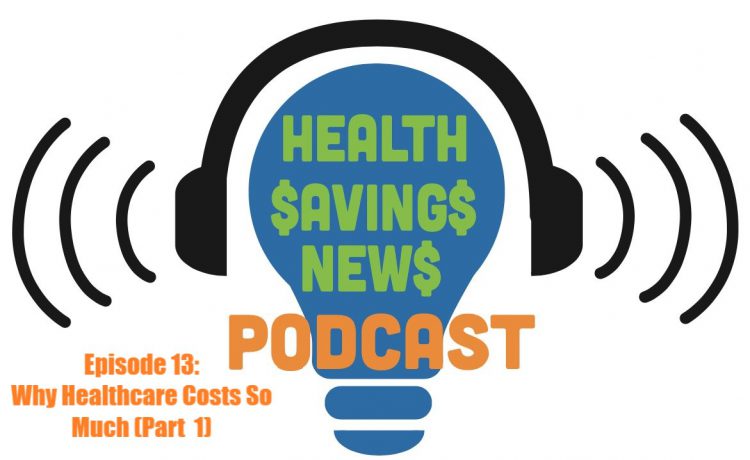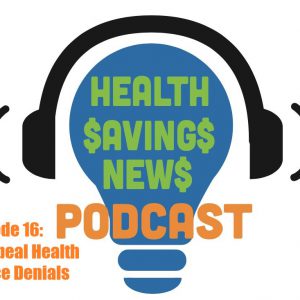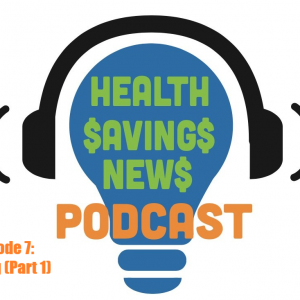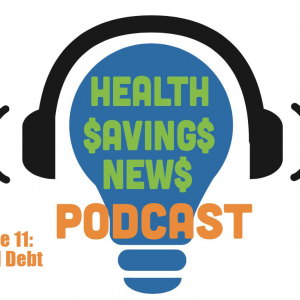Note: This is a rough transcript of episode 13 of Health Savings News and has been lightly edited for clarity. Copy may not be in its final form.
Evan (00:10):
Hello, and welcome to Health Savings News: the podcast about healthcare costs in America and how to save money on the often expensive care all kinds of people need. I’m your host, Evan O’Connor, joined by retired doctors, Rich Sagall and Mike Woods. Each episode we discuss healthcare costs in America, offer tips for saving money, and relevant news that affects and reflects the expensive landscape of healthcare in America.
This week’s topic is why healthcare costs so much. We’re going to break this into separate episodes for systemic and medical reasons. When we talk about systemic reasons for why healthcare costs so much, we want to make clear that this is not an indictment on any one or any industry. Our aim is simply to describe where we are and how we got here. Prohibitively expensive healthcare is a problem, but it’s not a problem that we got into yesterday. No one person brought us to this moment. It’s collective and bipartisan. The road bringing us here has been long, and any path to a better system will also be long. The three of us aren’t going to solve this problem. No system is perfect. But the information and context given here will speak to nearly all the episodes we’ve already done and will do in the future. I want to start by giving a huge shout out to the podcast Throughline from NPR, hosted by Ramtim Arablouie and Rund Abdelfatah, whose team did a ton of work and research into the history of this topic back in 2020. If you want to know more about the history I’m about to quickly summarize here, check out their incredible episode, The Everlasting Problem, and we’ll have a link to that and the podcast description as well.
The first forms of what could be considered health insurance began in the 1910s during industrialization. At the time, insurance was not meant to cover healthcare costs because Americans weren’t spending much on healthcare. Most people were treated at home by a local doctor or someone they knew. Insurance covered the lost income for wage-earning people who were struck by illness or injury. By 1915, the sickness funds covered around 8 million workers. By the 1920s, the healthcare industry was advancing. Hospitals were changing from a place where people in poverty would go to die into places where higher income people would go to give birth. Healthcare costs began to rise for Americans and hospitals faced financial crises when patients were unable to pay. An educational and hospital administrator named Justin Ford Kimble developed a program where patients could prepay for healthcare and formed the first private health insurance Blue Cross. Deciding it was easier to sell health insurance to employer groups instead of just selling to individuals, Blue Cross launched a pilot program in 1929, selling hospitalization policies that entitled teachers to get two weeks of paid hospital care when they had a baby for 50 cents a month to schools in Dallas, Texas. While the program was successful and launched nationwide, it covered relatively few people and was not comprehensive. Physicians largely opposed introducing third party payers, which they viewed as a threat to their autonomy at the time, but eventually entered the private health insurance arena when confronted with a looming threat of nationalized healthcare as promised by FDR during the Great Depression. Before the United States entered World War II, only 4% of the United States population had health insurance. Everyone else paid out of pocket or relied on charitable organizations if they were unable to pay. As Americans left to serve overseas, the nation faced a labor shortage. Economists worried rising competitive salaries meant to attract workers would affect inflation, leading to government imposed wage and price controls. To appeal to workers, employers began offering benefits such as health insurance. At that time, the IRS decided not to tax employer-provided health insurance. This was the beginning of American health coverage being tied to employment. After World War II, European countries devastated by the war, were forced to deal with their populations and dire need of shelter, clothing, food, and healthcare. Just to survive. The systems from country to country would vary, but universal healthcare began to spread across Europe. In the United States, President Harry Truman fought for FDR vision of universal healthcare, but was opposed by industries and unions alike. Unions didn’t want to lose health insurance as a bargaining chip in contract negotiations, and industries argued that employer based insurance would solve the problem without government intervention. At the legislative level, racism of opponents refusing to finance universal healthcare that would heavily benefit Black Americans in the South and their growing culture of fear of socialism doomed even a weaker version of Truman’s Universal Healthcare Bill. By the 1950s, the IRS was reconsidering private health insurance’s tax free status. When President Eisenhower approached Congress to make the tax exempt status of employer contributions to health insurance permanent, they cemented Americans’ dependence on employer-based health insurance and essentially silenced efforts to nationalize healthcare. However, this left many people uninsured: Black people, elderly and retired people, agricultural workers and service industry workers did not receive the benefits of employer based health insurance. Shortly after JFK was elected president in 1960, his father had a stroke. Kennedy later joked it was a good thing that his father was richer than the president so he could afford his healthcare. But the joke touched on a question that still haunts many more than 60 years later: what our ordinary people supposed to do? This led to his passion to pursue Medicare, which was signed into law in 1965 by President Lyndon Johnson, where Harry Truman received Medicare card number one.
The United States has by far the most expensive healthcare system in the world. And the system we have now follows the same trends of our history. The failure to provide adequate coverage led to the development of employer-based insurance, which led to reformers focusing on the people who were not covered by employers. We have Social Security, Medicare, Medicaid, COBRA, the Child Health Insurance Plan, the Affordable Care Act. We just keep trying to fill in the gaps. But even with all these efforts, there’s still millions of people who fall into the cracks that remain and don’t have any protection.
Mike (05:44):
When looking at health insurance, one of the first thing we’re going to discuss is how healthcare insurance costs contribute to the high cost of medical care. Following the history of of healthcare, Evan just provided, many influences continue to cause healthcare insurance to evolve over time and will continue to do so going forward. Medical knowledge increases and healthcare improves over time. Policies continue to adapt over time to new conditions and technologies that have been discovered. New tests and imaging techniques that have been developed and new medical procedures and medications that will benefit patient care. The federal and local governments pass new healthcare and healthcare insurance laws all the time that companies must also incorporate into their policies. For example, the Affordable Care Act of 2010 banned the refusal of insurance for preexisting conditions and allowed parents to keep children on their policies until they were 26 years old. Both were extremely expensive to health insurance companies that used to be able to deny those with preexisting conditions to save money on not having to pay for their healthcare. Networks and formularies were created over time; that took time to make and involved expensive and time and difficult price negotiations. Insurance companies began to monitor the quality of healthcar, so they created outcome standards that provide us needed to meet and provided oversight of the provider’s performance for those outcomes. This all resulted in more roles and services in the health insurance and more complexity of the policies. This required more employees to manage all these new details resulting in higher costs with the administrative tasks necessary to run healthcare companies have made them into very large corporations with huge budgets. We spend about 8% of our healthcare dollar on healthcare insurance administrative costs. That’s about $940 per person per year. That’s more than we spend for preventive or long term care combined. Compare this with other countries who have some who have universal healthcare, where this percentage is anywhere from 0.6% to 5.7% or an average of $173 per person per year. About half the cost of the administrative contribution to medical care is because of the complexity of our system. Most costs for insurance companies are those that are necessary for running any successful business, but some have needed to be added over time as insurance companies assume more roles such as creating the networks and controlling access to them, creating formularies and negotiating lower prices. There are departments that process prior approvals and requests for non-formulary drugs and out network referrals. Each company has a number of case reviewers that review individual cases to decide what is appropriate and should be paid for, or inappropriate and rejected based on the patient’s policy. The complexity created by the huge number of health insurance companies in the large variety of policies that each has each with their own covered expenses, deductibles, co-pays, networks, formularies, and negotiated prices has also increased the need for insurance agents to meet with potential customers to meet matching policy to their individual needs or the needs of the company. The complexity has added to the administrative costs in the form of third party middlemen as well. Healthcare coordinators help patients navigate the system because it is so complex to do alone. Pharmacy benefit managers act as go-betweens between the health insurance company and pharmacies and pharmaceutical companies that they work with. Group person organizations are outside consultants that conduct price negotiations for the healthcare company.
Rich (10:26):
I’d like to talk about what I call four facts on health insurance. And these really apply to any insurance policy you may buy. The first one is you want to remember, you always lose with health insurance, there were two outcomes. Either you get sick and you need the benefits, or you spent a lot of money and got nothing because you remained healthy. Slight over simplification, but I think it’s important to remember that. The second one is what you should get from health insurance is peace of mind that you will not go broke if you get sick. And this does not seem to be the case with many health insurance programs these days, 50% or so of bank of individual bankruptcies due to healthcare costs. The third fact, there’s no such thing as a free lunch. It’s all a matter of cost shifting. If we want to add benefits to health insurance, someone has to pay for it, and the person that’s going to be is those who buy the policy. So if you add mental health benefits, for example, then someone has to pay for all this and we spread it out over all the enrolls in the insurance program. And the last thing to remember, it’s important there that health insurance does not limit your options. It limits what it will pay for. So you can see any physician you want, but it may not pay for that coverage. So I think it’s important to remember these four facts about health insurance.
Mike (11:45):
Yeah, remember, when you buy healthcare, you buy it before you even need it. So a simple analogy is that it is similar to gambling. You pay a lot of money in the hopes of getting one of those two negative outcomes that Rich provided. One of the most important things that make health insurance companies solvent is the fact that the people who are healthy for the most part pay for the very ill individuals. So for the most part, most of us who are very healthy are not getting our money’s worth. We’re merely supporting the system so that it doesn’t fail because of the number of sick individuals.
Rich (12:28):
And the system is there to cover your health costs if all of a sudden you go from being a healthy person to a sick person.
Mike (12:35):
Exactly.
Evan (12:37):
I just wanted to make one note on the health insurance doesn’t limit your options. It limits what they themselves will pay for. For a lot of people that does limit their options. Cause if someone can’t afford a healthcare service they need, then they probably can’t get that healthcare service. I understand that people are free to pay for things outside of insurance, but a lot of people are totally unable to. And that’s kind of what this podcast is about.
Rich (13:02):
Well, that’s very true. I’m not disagreeing with that at all.
Mike (13:05):
Yeah, they’ll let you do it as long as you can pay for it, but those who can’t are out of luck.
Rich (13:11):
I totally agree.
Evan (13:12):
The bottom line is that healthcare prices are higher across the board. They’re increasing faster than other goods and services that we pay for. There’s a lot, a lot of systems in place that, again, no one alive today put those systems there. We’re all just existing here. The United States doesn’t regulate or negotiate the prices of prescription drugs other than for Medicare and Medicaid. Drug makers are allowed to set their own prices around a given product leading to excessive drug prices being the single largest area of healthcare overspending in the United States. Many drugs cost more than $120,000 a year. A few approach a million dollars annually. The Department of Health and Human Services estimates that Americans spend $460 billion on drugs each year. These high prices are based on profits and not how much it costs to develop and produce. Even Paxlovi which treats COVID is the fastest selling drug of all time. Treatment costs $530 per person, which earned Pfizer 1.5 billion in the first quarter of 2022. And even there, price hikes for existing brand name drugs are the biggest contributing to rising drug prices. It’s not the research and development of new obviously necessary drugs.
Mike (14:28):
One of the other things that contributes to high healthcare costs is how we pay our providers. In the 1990s and early 2000s, the predominant healthcare system was a managed care system. And even though it’s fallen out of favor, some HMOs still exist. This is a throwback to the earliest health coverage when an employer paid a doctor a set amount to provide medical care for their employees. In its current version, healthcare providers and healthcare groups are given a specific amount of money per year to manage their patients. And this is all they will get paid regardless of how many times they see their patients with the actual cost of medical care. From the hospital perspective, there were only reimbursed on the patient’s diagnosis, not on the actual cost of their hospital stay. So a patient who ended up in the hospital with a significant amount of complications afterwards resulted in a big financial loss for the hospital. For the first time with HMOs networks were created extensively. These gave providers less expensive specialists to refer to, but limited provided choices in patient access. HMOs involved incentives where providers could receive bonuses for good management or penalties for poor management. And although it did reduce the number of referrals to specialists it also reduced the overall number of patient visits to the detriment of patients because they were missing out on doctor visits that would’ve been beneficial. Because of the restricted feeling that both providers and patients felt the HMO fell out of favor. So now we’re in a fee-for-service system, which was most popular before the HMOs, but it does come at a higher cost and does have some drawbacks. A fee-for-service incentivizes the healthcare provider to increase the number of patients seen per day by shortening each visit. They may also have the incentive to provide unneeded or more expensive services simply to increase their reimbursement. Like some follow up visits, which was a topic of one of our previous podcasts. And superfluous examinations treatments into a lesser extent tests. Remember now, government regulation and oversight only protect the quality, privacy, integrity of your healthcare. The government, except for, as Evan said, Medicare and Medicaid has very little, if any, oversight over healthcare fees. This means that hospitals, provider networks, testing facilities, and drug manufacturers are essentially free to charge whatever the insurance network and patients are willing to pay. So prices at this point in time are based primarily on negotiation rather than actual costs. So this is one of the reasons why you see the same procedure vary significantly in cost from location to location. A lot of health networks are now beginning to merge and grow. And unfortunately, this lack of competition also increases prices. And as we’ve talked about before, all of this has the greatest effect on those without health insurance who do not have the benefit of negotiated prices that health insurance companies obtain.
Evan (17:59):
Something I have said on a previous podcast, even if you’re uninsured, if you get a outrageous bill from a hospital or other healthcare facility that is obviously inflated and meant to be negotiated down by a insurance company, contact them, say, “charge me less and maybe you’ll get paid” because that’s how it works, honestly.
Rich (18:21):
I think the concept of hospitals getting paid a flat amount based upon diagnosis needs to be expanded upon. The amount that they’re getting paid was designed to take into account to cases that are very easy to deal with and the cases that are very complicated and come up with an averaging. I think part of the goal was to limit some of the billing process and make it easier to project income and costs. So it wasn’t all bad. Insurance companies have made a number of changes in clinical practice by looking at the vast amount of data they have, looking at the procedures and trying to decide what really makes sense. It’s a misconception that more medical care is better medical care, and it’s easy for physicians to increase their income by having more visits. I agree with that, but it doesn’t mean it’s better medical care.
Evan (19:14):
Yeah, more healthcare does not mean better healthcare. More expensive healthcare doesn’t mean better healthcare. Multiple studies show American spend more money, but often have worse health outcomes than other nations. American doctors have the highest average pay for their profession than anywhere else in the world.
Mike (19:32):
I just want to emphasize that the paying the hospitals for diagnosis was a feature of HMOs, which are very rare now and are not a feature of fee-for-service environments.
Rich (19:46):
I think we should also discuss how unique healthcare is from other commodities people may buy, such as getting their automobile fixed, carpentry work on the home, et cetera. Healthcare is one of the only areas where you need somebody in between you and the service or procedure you want. Most other times you can just order it. You can do it yourself, whether it’s getting your oil changed, whether it’s getting an engine rebuild, whatever it is you decide. But in medicine and health, you need a physician or another provider to act as a middle person. Now, some of this is changing. You can have many blood tests on your own, pay for them on your own without a provider’s order, but you still need a provider for most things, including most medications. Another difference is you may have little choice where you can get these procedures done if insurance is going to cover it. So as Mike had alluded to, you may have to go a distance or may not be the provider you want to get. Much of what is done, the user really doesn’t understand. If you show up with a problem, you’re not going to understand why certain tests need to be done or it may not be done. That’s up to the provider to decide and to explain to you. But it’s different than other services you buy, and it’s hard to go against the provider’s recommendation. We may talk about ways to save money, but it’s not always easy to say, “Doc, I don’t like that idea.” More and more patients are doing that, but it’s hard to go against your recommendations. It’s also hard to shop around. If your doctor says you need to get an MRI at this facility because it’s the best, who are you to say “no, it’s not” just because it’s the most expensive. So it’s difficult to shop around. Sometimes you need something done right away and you don’t have time to shop around. Another point that Mike made is competition doesn’t always result in lower prices. I remember reading a study looking at an influx of new gastroenterologists into a community; rather than procedure cost going down, more procedures were done. So it had just the opposite of saving money. And lastly, healthcare is an emotional thing. You probably don’t express the same emotion when you’re dealing with a car that’s not running properly. But when it’s a child that’s not feeling well, it’s a very emotional situation and you want the best care, as much care as you can get at that time and not be concerned about the cost. So those are some differences between healthcare and other commodities.
Mike (22:11):
So those are some of the reasons based on our current system of medical care why healthcare is so expensive. There are more that we haven’t touched on and a lot of them that are related to the nature of medical care itself, which we will discuss in the next podcast.
Evan (22:30):
The profit-based approach to healthcare has persisted and is responsible for healthcare costs growing faster than both the economy and inflation. The limited financial regulation allows providers, healthcare facilities, pharmaceutical companies and pharmacies to literally set their own prices. This is the primary contributor to higher healthcare costs in this country, and because of this and the complexity of the system, providers can set prices for medical services at what the market will bear — or higher.
[segment break]
Evan (23:02):
The last segment of each episode, we suggest some of the culture, art, entertainment, and social causes we’ve been engaged with to each other and our listeners.
Rich (23:09):
I have a book I’d like to recommend. It’s called Let Them Eat Dirt: Saving Your Child From An Over Sanitized World. It was, the version I have was from 20 20 16, but I think what they say is still relevant. It’s written by two microbiologists, and the basic concept is we are living in two clean a society. Children are not exposed to enough things leading to allergies and asthma. And he jokingly said at an interview that it’s a good idea if your child eats a little dirt now and then to be exposed to these various pathogens or allergens. So it’s an interesting book. I highly recommend it again. It’s called Let Them Eat Dirt.
Mike (23:54):
Yeah, I’ve actually talked to people that have visited this country from overseas, and they actually comment on that particular aspect of our culture at how over-sanitized our environment is here.
Rich (24:09):
Well, it’s a little disheartening to see parents bring out their little bottle of hand sanitizer every time the child’s going to eat anything; probably unnecessary.
Mike (24:18):
Speaking of dirt, I want to talk about one medical myth that’s actually still used is: when you actually need a tetanus shot. When I’ve worked in ERs and other outpatient situations, when people come in with clean laceration, everybody wants to give them a tetanus shot, whereas the tetanus infection is actually growing in the soil. And any cut that’s contaminated with dirt, even down to a skin knee, is what should prompt a tatan shot and not a very clean laceration.
Evan (24:55):
I have a podcast this week. It’s called An Arm and a Leg from Kaiser Health News hosted by award-winning reporter Dan Weissman. It’s a show about why healthcare costs so much and what we can do about it. It’s entertaining and empowering and useful. I like to think we’re similar to their show if we had a team of journalists and a higher production value. It’s a really great show provi from a source that I use a lot in my writing and my research. It’s An Arm and a Leg from Kaiser Health News.
Thank you so much for joining us for this episode of Health Savings News. Please subscribe, rate, and review us on Apple Podcast or wherever you’re listening to the show, it really does help. You can follow @NeedyMeds on Twitter, Facebook, Instagram, LinkedIn, YouTube, and you can follow @HealthSavingPod (no S at the end of saving) on Twitter for updates specific to this podcast and send questions, comments, and topic suggestions to podcast@needymeds.org. Our music is composed by Samuel Rulon-Miller. His music can be found at musicisadirtyword.bandcamp.com. The Health Savings News podcast is produced by me, Evan O’Connor. All the sources we used in our research can be found in the episode’s podcast description on our website or your podcast app of choice. Health Savings News is not intended to substitute for professional medical, financial, or legal advice. Always seek the advice of a qualified healthcare professional, or appropriate professional with any questions. Views expressed on Health Savings News are solely those as the individuals expressing them. Any views expressed do not necessarily represent views in Health Savings News, other contributors, the NeedyMeds organization, or staff. Thanks again for listening. See you in two weeks with our next episode.
Sources:
https://www.npr.org/2020/09/28/917747287/the-everlasting-problem
https://www.cnbc.com/2018/03/22/the-real-reason-medical-care-costs-so-much-more-in-the-us.html
https://www.pgpf.org/blog/2020/04/why-are-americans-paying-more-for-healthcare
https://pubmed.ncbi.nlm.nih.gov/29536101/
https://www.ncbi.nlm.nih.gov/pmc/articles/PMC5818797/
https://www.thebalance.com/causes-of-rising-healthcare-costs-4064878#government-policy
https://www.thebalance.com/causes-of-rising-healthcare-costs-4064878
https://www.brookings.edu/research/a-dozen-facts-about-the-economics-of-the-u-s-health-care-system/
https://www.nytimes.com/2018/07/16/upshot/costs-health-care-us.html
https://www.ncbi.nlm.nih.gov/pmc/articles/PMC4283267/
https://www.cnbc.com/2019/01/10/why-prescription-drugs-in-the-us-cost-so-much.html
https://www.vox.com/a/health-prices
https://www.careeraddict.com/top-5-countries-with-the-highest-paid-salaries-for-doctors
https://blog.definitivehc.com/top-10-hospital-performance-metrics-you-need-to-know
https://www.kff.org/health-costs/issue-brief/what-we-know-about-provider-consolidation/
https://study.com/academy/lesson/federal-state-regulation-of-healthcare-organizations-providers.html
https://www.consumerreports.org/healthcare-costs/paying-for-healthcare-in-the-age-of-coronavirus/





